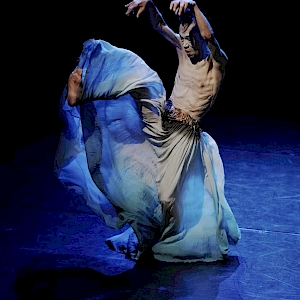Kasai Akira Post Butoh Performance "Dancing John the Apostle" [Video distribution of performance recording]

The apocryphal text known as the “Acts of John” records Jesus as having proclaimed: “Thou that dancest, perceive what I do, Whoso danceth not, knoweth not what cometh to pass.” Likewise, the gospel of John teaches: “And the Word was made flesh and dwelt among us […]This is now the third time that Jesus showed himself to his disciples, after that he was risen from the dead.”
While I may harbor confusions, I will attempt to give expression to John himself through my words and through my body.
Kasai Akira
The Welcome Event for New Students began in 1994 with a Butoh performance by Ohno Kazuo at Hiyoshi Campus. The theme of that day was “heart, body, and mind” which has become an important concept at Hiyoshi Campus, with performances from representative Japanese butoh artists receiving a wonderful response every year. A video recording of Kasai Akira’s planned butoh performance at the Hiyoshi Raiosha will be distributed online.
*Flyer Download
Date
December 24th 2021, 1pm starts
Venue
Online(Youtube)
Audience
Open to everyone / Come and go anytime
Cost
Free participation
Enquiries and bookings
Keio University Art Center (Ishimoto)
Tel. 03-5427-1621 Email: pj.ca.oiek.c-tra@otomihsi
Performance[Keio University Freshman Event 2021]
Date
December 24th 2021, 1pm starts
Venue
Online(Youtube)
Audience
Open to everyone / Come and go anytime
Cost
Free participation
Booking
No reservations required
Please access the link when the opening time comes.
Please fill in the the questionnaire after the event. (See below)
Lecturer/Performer
Performance title “Dancing John the Apostle”
Performer Kasai Akira
Recitation Kasai Reiji
Sound/Lighting S.O.G.A.
Text: Gospel of John
Chapter 1 Verses 1-14
Kana’s wedding
The Raising of Lazarus
Pontius Pilate
Crucifixion–Burial–Resurrection
Revelation of St. John the Divine (Book of Revelation) Chapter 12
Music Composer: J.S. Bach Passio secundum Joannem Chorus, Chorale, and Aria
Kasai Akira was born in Mie Prefecture in 1943. His childhood was marked by the strict discipline of his father Torao, a judge, who he lost to the Toya Maru ferry accident on September 26, 1954. Although he has never been baptized, he has extensive experience with the Christian lifestyle, and it would be safe to characterize the historical “Resurrection of Jesus” as one of Kasai’s lifelong themes. He entered the world of dance following his studies at the studio of Eguchi Takaya and Miya Misako, and would go on to meet Ohno Kazuo and study directly under him for three years. In October 1963 he encountered Hijikata Tatsumi as a dancer in the Gi-gi (“Sacrifice Ceremony“) at Asahi Hall and would later perform in “A Rose-colored Dance: A LA MAISON DE M. CIVECAWA” at Sennichidani Hall, in November 1965. He established his own studio, the Tenshi-kan (“House of Angels”), in 1971, and lived in Germany from 1979 to 1985. His practice takes in eurhythmy and pantomime, and is not constrained by “butoh” in its narrow sense.
A highly regarded writer, his position of emphasizing mystery and spirituality is expounded in his books Tenshi-ron (“About Angel”), Seirei Butoh (“Spiritual Butoh”), and Tomei Meikyuu (“A Crystal Labyrinth”) – a photographic collection produced in collaboration with Eikoh Hosoe – among many other published works. His works cover a broad range of topics from Western occultism through to Oishigori Masumi’s “Shinkun Kojiki” (“Chronicles of Shinkun”), and sublimates them into “dances” which transcend mere quotidian language, earning him an ardent fan base as an author. Meanwhile, just as he puts it that: “I can hear the music of the heavens” (Spiritual Butoh, p.9), and asserts that “The Holy Spirit is energy, and one cannot live for a single moment without it” (Spiritual Butoh, p.26.), as a dancer he gives his audiences a sense of the cosmic as well as of tradition, transcending Modern Japan through a pre-modern, European, “Dance Cosmology.” He is, in essence, embodying the irresoluble mysteries of the gods found, for example, in the poetry of Sir John Davies, 1569-1626.
As Kasai states at the beginning of The Body and Life: Super Generational Dance: “As long as history is a living entity in the continual process of change, any era is a turning point. Nevertheless, rather than each person living continually across all eras, humans are confined to specific time periods, with their own sense of how the era in which they actually live constitutes a turning point. Such perception will involve marshaling their imaginations to achieve a bird’s eye view of history as a whole.” Such sentiments illustrate Kasai’s strong awareness that modernity and the social are also pivotal to dance. A recipient of the Minister of Education Award for Fine Arts for his 2013 performance “Dancing the Constitution of Japan.” (Hayato Kosuge)
Enquiries and bookings
Keio University Art Center (Ishimoto)
Tel. 03-5427-1621 Email: pj.ca.oiek.c-tra@otomihsi
Organiser(s)
Organised by: HAPP, Keio University Art Center
Coordinated by: Hayato Kosuge
Please fill in the questionnaire after the event.